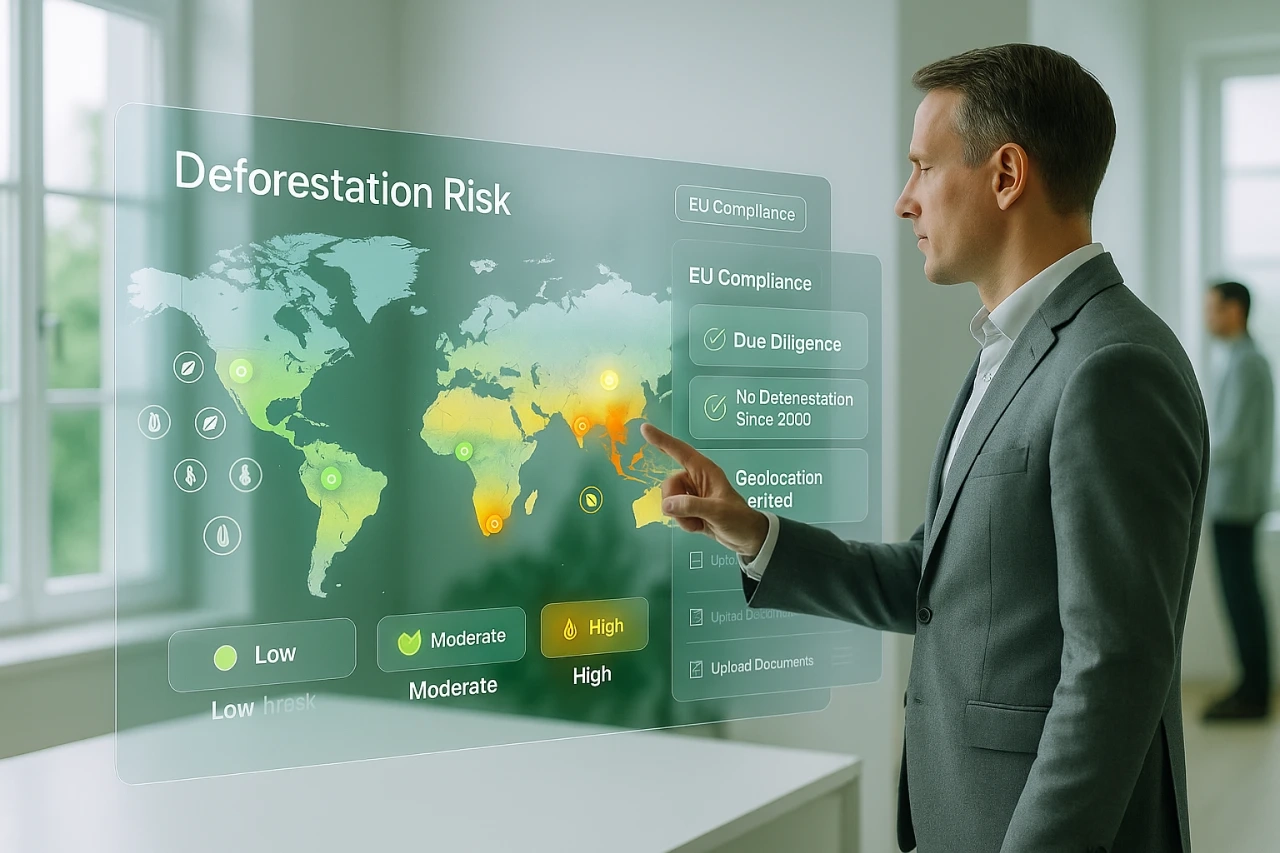European Deforestation Regulation (EUDR): What Companies Need to Know to Ensure Compliance

Global deforestation is one of the leading drivers of climate change and biodiversity loss. According to the FAO, nearly 10 million hectares of forest disappear every year, mainly due to agricultural expansion. As the world’s second-largest importer of embedded deforestation, the European Union has decided to act. It is in this context that Regulation (EU) 2023/1115, known as the European Union Deforestation Regulation (EUDR), was adopted. Its objective: to prohibit the placing on the EU market or export of products linked to deforestation after December 31, 2020.
But beyond its environmental goal, this regulation significantly transforms how companies manage their supply chains. It introduces new obligations around traceability, compliance, and due diligence that will affect all stakeholders—importers, manufacturers, distributors, and public operators.
Understanding the European Deforestation Regulation
The EUDR was published in the EU Official Journal on June 9, 2023, and entered into force on June 29, 2023. It applies to commodities most associated with deforestation:
- Palm oil
- Cattle
- Wood
- Coffee
- Cocoa
- Rubber
- Soya
The annex also includes derived products such as chocolate, paper, furniture, and certain cosmetics and hygiene products.
The regulation’s goal is clear: ensure that products consumed or exported from the EU do not contribute to deforestation or forest degradation.
Timeline and Deadlines
Although the regulation is in force, its effective application has been delayed by one year to allow companies time to prepare.
| Type of Company | Original Application Date | New Application Date |
|---|---|---|
| Large Enterprises | December 30, 2024 | December 30, 2025 |
| Micro, Small, and Medium-sized Enterprises | June 30, 2025 | June 30, 2026 |
From December 30, 2025, all large enterprises placing regulated products on the EU market must prove they are “deforestation-free.” SMEs will have an additional six months to comply.
Key Obligations for Companies
The regulation requires companies to implement a structured due diligence system to ensure product compliance and traceability.
1. Due Diligence
Companies must:
- Collect information about suppliers, material origins (plot-level geolocation), volumes, and local compliance.
- Assess the risk of deforestation or legal non-compliance in the country of origin.
- Implement mitigation measures such as audits, contractual guarantees, or enhanced monitoring.
2. Traceability
Each company must be able to geolocate the source plot of raw materials and prove no deforestation has occurred since December 31, 2020.
3. Legal Compliance
Products must comply with all relevant environmental, land use, and labor laws of the country of origin.
4. Declaration and Documentation
Before being placed on the market, a due diligence statement must be submitted to the European Information System. This document, accessible to authorities, proves product compliance.
5. Controls and Sanctions
Member States will conduct regular checks.
Non-compliance may lead to fines of up to 4% of annual EU turnover and even temporary bans on marketing the products.
These obligations are prompting companies to adopt TPRM solutions that automate third-party interactions and documentation.
Key Challenges in Achieving Compliance
1. The Complexity of Traceability
Obtaining reliable geolocation data—especially in long or informal supply chains—is a major challenge.
2. Inclusion of Small Producers
Local actors often lack the technical resources to comply and risk exclusion from the European market.
3. Cost and Administrative Burden
Audits, data collection, and system updates require significant effort.
4. Commercial Risk
Non-compliant products may be blocked at EU borders, leading to major economic impacts.
5. Varied National Approaches
Each Member State will apply the regulation based on its resources and priorities, creating potential disparities in enforcement.
How to Prepare Effectively
The key to EUDR compliance lies in anticipation and structure.
Companies should:
- Map their supply chain
- Identify affected products and suppliers
- Implement automated ESG and geolocation data collection systems
- Train internal teams
- Centralize all information in a unified platform
Solutions like Aprovall already enable digitization of these processes: third-party assessment, document traceability, compliance checks, supply chain mapping, and automated alerts.
A Broader Regulatory Ecosystem
The EUDR is part of a larger regulatory ecosystem, including the CSRD (non-financial reporting) and the upcoming CSDDD/CS3D (Corporate Sustainability Due Diligence Directive).
These regulations converge toward a shared ambition:
“Ensure that European companies operate in a sustainable, transparent, and human- and environmentally respectful manner.”
In other words, the EUDR is just the first step toward a responsible, verifiable European supply chain.
Ready to strengthen your third-party risk management program?
These articles might interest you
-
 04 April 2025Understanding Key Financial Indicators for Evaluating Your Third-Party PartnersSolutionsIn an economic environment where over 60% of European companies have faced operational incidents linked to their third-party partners, as highlighted by the European Central Bank in its Annual Report on Supervisory Activities, understanding and mastering key financial indicators has become essential for evaluating the stability of your business partners. These third-party assessment tools help […]
04 April 2025Understanding Key Financial Indicators for Evaluating Your Third-Party PartnersSolutionsIn an economic environment where over 60% of European companies have faced operational incidents linked to their third-party partners, as highlighted by the European Central Bank in its Annual Report on Supervisory Activities, understanding and mastering key financial indicators has become essential for evaluating the stability of your business partners. These third-party assessment tools help […]Read more
-
 17 February 2025Supplier Due Diligence: A Key Pillar in Risk ManagementSolutionsSupplier due diligence has become a critical component of third-party governance in a context where nearly 50% of mergers fail due to inadequate partner assessment. This structured approach to collaborative evaluation enables organizations to build operational resilience while ensuring regulatory compliance. The due diligence process is based on a proven methodology of gathering and analyzing third-party information. It systematically covers six critical […]
17 February 2025Supplier Due Diligence: A Key Pillar in Risk ManagementSolutionsSupplier due diligence has become a critical component of third-party governance in a context where nearly 50% of mergers fail due to inadequate partner assessment. This structured approach to collaborative evaluation enables organizations to build operational resilience while ensuring regulatory compliance. The due diligence process is based on a proven methodology of gathering and analyzing third-party information. It systematically covers six critical […]Read more
-
 20 February 2025Automating Sapin II Compliance Controls: A Technological Solution for Regulatory ConformitySolutionsIn a constantly evolving regulatory environment, French companies face increasing challenges in complying with Sapin II law, particularly regarding anti-corruption efforts. These requirements are especially critical in strategic sectors such as the public sector, construction, industry, and retail, where partner-related risks are omnipresent. Automating compliance controls through advanced technological solutions offers an effective way to manage these complex issues. By […]
20 February 2025Automating Sapin II Compliance Controls: A Technological Solution for Regulatory ConformitySolutionsIn a constantly evolving regulatory environment, French companies face increasing challenges in complying with Sapin II law, particularly regarding anti-corruption efforts. These requirements are especially critical in strategic sectors such as the public sector, construction, industry, and retail, where partner-related risks are omnipresent. Automating compliance controls through advanced technological solutions offers an effective way to manage these complex issues. By […]Read more
-
 27 March 2025Understanding the Scope 3 Data Collection Methodology under the CSRDSolutionsThe Corporate Sustainability Reporting Directive (CSRD) is radically transforming the landscape of non-financial reporting in Europe, imposing stricter third-party governance in terms of sustainability. As part of the European Green Deal, this directive is a key pillar of the EU’s strategy to channel financial flows toward a more sustainable economy. Although its rollout is currently […]
27 March 2025Understanding the Scope 3 Data Collection Methodology under the CSRDSolutionsThe Corporate Sustainability Reporting Directive (CSRD) is radically transforming the landscape of non-financial reporting in Europe, imposing stricter third-party governance in terms of sustainability. As part of the European Green Deal, this directive is a key pillar of the EU’s strategy to channel financial flows toward a more sustainable economy. Although its rollout is currently […]Read more
